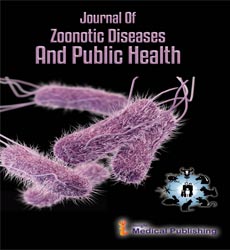Agents Causing Zoonotic Disease and Zoonotic Viruses
Vicki Everett*
Department of Science, University of Belgrade, Belgrade, Serbia
- *Corresponding Author:
- Vicki Everett
Department of Science,
University of Belgrade,
Belgrade,
Serbia,
E-mail: vicki.187@gmail.com
Received Date: September 17, 2021; Accepted Date: October 01, 2021; Published Date: October 08, 2021
Citation: Everett V (2021) Agents Causing Zoonotic Disease and Zoonotic Viruses. J Zoonotic Dis Public Health Vol.5 No.S1:002.
Description
A zoonosis is an irresistible sickness brought about by a microorganism (an irresistible specialist, like a bacterium, infection, parasite or prion) that has jumped from a creature (typically a vertebrate) to a human. Ordinarily, the main contaminated human sends the irresistible specialist to undoubtedly another human, who, thus, taints others.
Significant present day illnesses, for example, Ebola infection sickness and salmonellosis are zoonoses. HIV was a zoonotic illness sent to people in the early piece of the twentieth century; however it has now changed to a different human-just sickness. Most strains of flu that taint people are human illnesses, albeit many strains of bird influenza and pig influenza are zoonoses; these infections periodically recombine with human strains of this season's virus and can cause pandemics like the 1918 Spanish influenza or the 2009 pig influenza. Taenia solium contamination is one of the dismissed tropical sicknesses with general wellbeing and veterinary worry in endemic districts. Zoonoses can be brought about by a scope of illness microorganisms, for example, developing infections, microbes, growths and parasites; of 1,415 microbes known to taint people, 61% were zoonotic. Most human illnesses began in creatures; notwithstanding, just sicknesses that regularly include nonhuman to human transmission, like rabies, are considered direct zoonoses.
Significant present day illnesses, for example, Ebola infection sickness and salmonellosis are zoonoses. HIV was a zoonotic illness sent to people in the early piece of the twentieth century; however it has now changed to a different human-just sickness. Most strains of flu that taint people are human illnesses, albeit many strains of bird influenza and pig influenza are zoonoses; these infections periodically recombine with human strains of this season's virus and can cause pandemics like the 1918 Spanish influenza or the 2009 pig influenza. Taenia solium contamination is one of the dismissed tropical sicknesses with general wellbeing and veterinary worry in endemic districts. Zoonoses can be brought about by a scope of illness microorganisms, for example, developing infections, microbes, growths and parasites; of 1,415 microbes known to taint people, 61% were zoonotic. Most human illnesses began in creatures; notwithstanding, just sicknesses that regularly include nonhuman to human transmission, like rabies, are considered direct zoonoses.
In most RNA infections, the acknowledgment of a "species" is characterized by an incredible variety of determination instruments or conditions, too huge to even consider being talked about in this text. A portion of these limitations are because of human propensities and to the versatility of human populaces; others are because of human propensities and to the portability of human populaces; others are because of geographic conditions. By and large, the confining conditions are not perceived to all. For instance, the infection of Venezuelan pony encephalitis, an alpha infection, regularly exists in enzootic cycles, where it is communicated by mosquitoes. Every now and then, variations of this infection seem which cause epizootic illnesses in ponies with a high pace of deadly encephalitis. Close to ponies, people are influenced by the infection. These epizootic or pestilence variations of the infection are not perceivable in the between plague periods, albeit the host repository of the enzootic variations is notable. Similarly, until now obscure infections may by chance taint the human populace and they cause flare-ups of extreme sickness.
Zoonoses have various methods of transmission. In direct zoonosis the infection is straightforwardly communicated from creatures to people through media like air (flu) or through nibbles and spit (rabies). Interestingly, transmission can likewise happen by means of a middle species (alluded to as a vector), which convey the infection microorganism without becoming ill. At the point when people taint creatures, it is called turn around zoonosis or anthroponosis. The term is from Greek: ζῷον zoon "creature" and νόσος nosos "disorder".
Host hereditary qualities assumes a significant part in figuring out which creature infections will actually want to make duplicates of themselves in the human body. Perilous creature infections are those that require not many changes to start recreating themselves in human cells. These infections are hazardous since the necessary mixes of changes may haphazardly emerge in the regular supply.
Open Access Journals
- Aquaculture & Veterinary Science
- Chemistry & Chemical Sciences
- Clinical Sciences
- Engineering
- General Science
- Genetics & Molecular Biology
- Health Care & Nursing
- Immunology & Microbiology
- Materials Science
- Mathematics & Physics
- Medical Sciences
- Neurology & Psychiatry
- Oncology & Cancer Science
- Pharmaceutical Sciences
